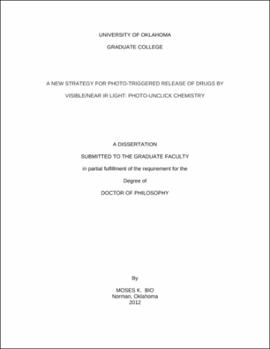| dc.contributor.advisor | YOU, YOUNGJAE||Glatzhofer, Daniel | |
| dc.creator | Bio, Moses Kwabena | |
| dc.date.accessioned | 2019-04-27T21:36:30Z | |
| dc.date.available | 2019-04-27T21:36:30Z | |
| dc.date.issued | 2012 | |
| dc.identifier | 99337430302042 | |
| dc.identifier.uri | https://hdl.handle.net/11244/319135 | |
| dc.description.abstract | Spatio-temporally controlled release of therapeutic or diagnostic agents by the use of light has gained much attention in recent times. Controlled release of bioactive molecules and drugs is a critical issue for many biological applications. In cell biology, caged compounds (photo-releasable compounds) have been used to study the molecular processes in biological systems. In drug delivery, controlled release of active form of drugs from inactive forms (prodrugs and nano-drug delivery carriers) is critical to achieve local expression of pharmacological action of the drug, especially toxic drugs such as anti-cancer drugs. Current strategies use UV light or short-visible light to release the active compounds. However, UV or short visible light can be used only at a cellular level. Its application at a tissue/animal level (in vivo) has been hampered by its limited tissue penetration. The other concern is the cellular damage by UV light itself. | |
| dc.description.abstract | To address the above limitations, our strategy was to develop a releasing mechanism based on the unique reaction of singlet oxygen generated by a combination of photosensitizer and low light energy. To achieve this our first goal was to identify chemical bonds which can be cleaved by tissue penetrable low energy light. We therefore systemically examined various substituted olefins to find the optimal linker for our strategy. This screening led to vinyl dithioether and vinyl diether as potential singlet oxygen mediated cleavable linkers. Both vinyl dithioether and vinyl diether were cleaved more than 80% by singlet oxygen within 15 min by the irradiation with 690 nm diode laser (200 mW/cm2) with a photosensitizer (core-modified porphyrin). Between the two, vinyl diether was our first choice because its photo-oxidation did not generate any side product. However, the synthetic methods for vinyl diether were limited to symmetric molecules, lengthy step and low yield. Due to such limitations of vinyl diether, the second screening was performed to identify better linker for our strategy. Among the screened linker candidates, aminoacrylate showed excellent characters: facile synthesis by a click chemistry, fast cleavage, and release of intact parent compound, stability in aqueous medium. We first introduced the concept of "photo-unclick chemistry" of aminoacrylate, where the aminoacrylate linker is synthesized by a click chemistry (amine-yne reaction) and intact drugs are released by irradiation. | |
| dc.description.abstract | A prodrug of drug-linker-photosensitizer CA4-L-PS was prepared to prove the photo-unclick chemistry in cells. The results obtained were consistent with our expectation. While the prodrug CA4-L-PS was 20 times less toxic than parent drug CA-4 without irradiation (IC50: 8 vs. 200 nM ). Photo-toxicity of CA4-L-PS was close to dark-toxicity of CA-4 (IC50: 6 vs. 8 nM), presumably due to the released CA-4. In addition, I also confirmed that the linker in the conjugate system could be cleaved at low intensity light (1 mW/cm2). It is a critical result to support the feasibility of photo-unclick chemistry at the systemic level because limited light intensity is the key problem. We further investigated the cleavage of the linker at systemic level (mouse) with a model compound PS-L-Rh, whose cleavage can be readily monitored by increase of Rh fluorescence. Light-dose dependent increase of Rh fluorescence was observed by IVIS bioluminescence imaging system in a nude mouse. The photo-unclick chemistry showed promising results. We envision that it could provide a novel releasing mechanism for spatio-temporally controlled release of biological active molecules from various drug delivery systems such as prodrug and nano-drug delivery vehicles. | |
| dc.format.extent | 130 pages | |
| dc.format.medium | application.pdf | |
| dc.language | en_US | |
| dc.relation.requires | Adobe Acrobat Reader | |
| dc.subject | Drug delivery systems | |
| dc.title | A NEW STRATEGY FOR PHOTO-TRIGGERED RELEASE OF DRUGS BY VISIBLE/NEAR IR LIGHT: PHOTO-UNCLICK CHEMISTRY | |
| dc.type | text | |
| dc.type | document | |
| dc.thesis.degree | Ph.D. | |
| ou.group | College of Arts and Sciences::Department of Chemistry and Biochemistry | |
